Physical Address
304 North Cardinal St.
Dorchester Center, MA 02124
The thyroid gland is one of the largest endocrine organs in the body. Despite this, surgical diseases of the thyroid gland in children are uncommon. In one study, thyroid disease requiring operative intervention was found to occur in 37 of 1000 school-aged children in the United States. Also, the incidence of thyroid cancer in children is increasing at a rate of 1.1% per year.
The thyroid arises as a diverticulum of endodermal thickening on the ventral wall of the pharynx, between the first and second pharyngeal pouches and dorsal to the aortic sac around the fourth week of gestation. Over the next 3 weeks, the primitive thyroid becomes lobulated and descends anterior to the hyoid bone and laryngeal cartilages to reach the lower neck. The path of migration is with the thyroglossal duct. Early in the fifth week of gestation, the proximal thyroglossal duct retracts and can be identified in adults as the foramen cecum. If the duct persists distally, it results in a pyramidal thyroid lobe. More proximal persistence results in a thyroglossal duct cyst that may become evident during childhood, often because of infection. Part of the thyroid gland originates from the fourth and fifth pharyngeal pouches, which contribute to the parafollicular C cells that produce calcitonin. The thyroid starts functioning by the end of the first trimester.
The thyroid gland produces thyroid hormone. The first step in thyroid synthesis is the iodination of tyrosine molecules, which are then coupled and form the thyroid hormones thyroxine (T4) and triiodothyronine (T3). T3 is the active hormone. When T4 enters the target cell, it is converted to T3 in order to become active. T3 then enters the nucleus of the target cell and binds to the nuclear thyroid receptors. This receptor–T3 complex binds to DNA to regulate genetic transcription, thereby regulating metabolism. Thyroid hormone also increases the effectiveness of catecholamines by sensitizing tissues, and is critical to normal neurologic development.
Thyroid-stimulating hormone (TSH), also known as thyrotropin, is secreted by the anterior pituitary gland in response to thyrotropin-releasing hormone released by the hypothalamus. TSH in turn stimulates specific receptors on thyroid follicular cells to increase thyroid hormone production. The production of thyroid hormone is dependent on dietary iodine intake and the ability of the follicular cells to concentrate the iodine. It is also important to note that >99% of the T3 and T4 released into the systemic circulation after thyroglobin undergoes proteolysis in the follicular cell is protein bound and therefore protected from cellular uptake.
Goiter refers to an abnormally enlarged thyroid gland, the etiology of which in children is broad and geographically different ( Fig. 75.1 ). In many parts of the world, endemic goiter is related to dietary iodine insufficiency. However, in developed countries, goiters can also be related to inflammatory conditions or nodular enlargement. The term simple goiter is used to refer to thyromegaly in a euthyroid person without a known cause such as iodine deficiency or an autoimmune condition. A study from Eastern Europe showed that simple adolescent goiters were the most common cause of thyromegaly followed by autoimmune thyroiditis. This study is interesting because it has a large number of children and comes from a region with iodinated water. Physiologically, a defect in hormone production, autoimmune diseases, or a response to an inflammatory condition can all result in diffuse thyroid enlargement. Goiters can be either diffusely enlarged or nodular, and are functional (toxic) or nonfunctional (euthyroid). Children with thyroid enlargement are often euthyroid and asymptomatic. Resection is rarely indicated, unless there are symptoms of mass effect.
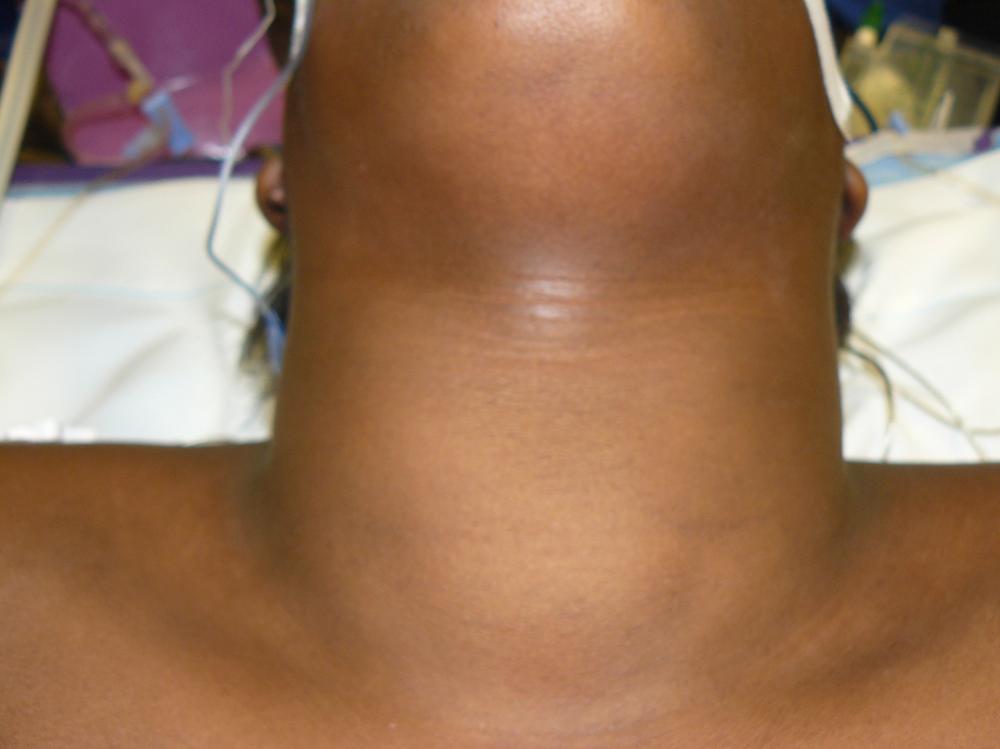
The differential diagnosis for diffuse thyroid enlargement is seen in Box 75.1 , illustrating the fact that a goiter is a typical but nonspecific finding of acquired thyroid disease with many etiologies. The patient’s history and exam will reveal hyperthyroid, hypothyroid, or no signs and symptoms, thereby guiding the differential diagnosis. Workup begins with plasma free T4 and TSH levels. A euthyroid patient (normal T4 and TSH levels) with thyromegaly has a simple colloid goiter. In addition, serum thyroid antibody levels are normal, and ultrasonography (US) will show uniform enlargement of the gland. The natural history of a simple goiter is not well known. One study of adolescents reported that nearly 60% of the glands were normal in size 20 years after diagnosis, but other studies have shown that a small percentage of patients with simple colloid goiter progressed to Hashimoto’s thyroiditis. Treatment of the thyroid enlargement with thyroid hormone may not significantly improve resolution of the goiter. Resection may be indicated because of the size and mass effect, but is uncommon.
Autoimmune mediated
Chronic lymphocytic (Hashimoto) thyroiditis
Graves disease
Simple colloid goiter
Compensatory
Iodine deficiency
Medications
Goitrogens
Hormone or receptor defect
Inflammatory conditions
Acute suppurative thyroiditis
Subacute thyroiditis
Chronic lymphocytic (Hashimoto) thyroiditis, also known as chronic autoimmune thyroiditis, is the most common cause of acquired hypothyroidism in children, with a prevalence of 1–2% and a 4:1 female predominance. It is another cause of diffuse thyroid enlargement, and goiter is the most common presentation of Hashimoto thyroiditis in children. Laboratory workup should include serum TSH and free T4, and antithyroid antibodies. About 85–90% of children will have high levels of antithyroid peroxidase (TPO) antibodies, and an almost equal number will have high antithyroglobulin antibodies. An additional 10% will have thyrotropin receptor blocking antibodies.
Thyroid imaging is usually not indicated and may even be falsely negative. However, in one study, follow-up US in 50% of patients after an initial negative US in children with other signs of chronic lymphocytic thyroiditis showed the typical changes within 7 months. The principal US finding is diffuse thyroid hypoechogenicity, which is nonspecific. In rare circumstances, autoantibodies cannot be detected. The diagnosis can be confirmed by fine-needle aspiration. In as many as one-third of adolescent patients, the thyroiditis resolves spontaneously, the gland becomes normal, and the antibodies disappear. Therefore, expectant management should be considered.
Exogenous thyroid hormone should be administered in the hypothyroid patient. However, in euthyroid children, it is more controversial, with some studies showing that thyroid hormone is ineffective in reducing the size of the goiter, whereas more contemporary studies show a decrease in goiter or thyroid size in euthyroid children. However, it can be difficult to determine how much of this decrease in size is related to the therapy or to the natural history of the disease.
Subacute (de Quervain) thyroiditis is a viral inflammation of the thyroid gland that is unusual in children. These patients present with a swollen, painful, and tender thyroid. Mild thyrotoxicosis from injury to the thyroid follicles can result in release of thyroid hormone, which in turn causes an increase in T3 and T4, with a decreased TSH. Decreased radioactive iodine uptake occurs due to thyroid follicular cell dysfunction. This finding distinguishes subacute thyroiditis from Graves disease. Granulomas and epithelioid cells can be found on histologic examination. Treatment is supportive: nonsteroidal anti-inflammatory agents or corticosteroids. Occasionally, if the initial hyperthyroid phase is symptomatic with a low serum TSH, then treatment with beta-blockade may be needed. Additionally, if the subsequent hypothyroid phase is severe and prolonged, short-term therapy with thyroid hormone replacement may be needed. Subacute thyroiditis usually lasts 2–9 months, with complete recovery being the norm.
Acute suppurative thyroiditis is a bacterial infection of the gland characterized by fevers, chills, hoarseness, dysphagia, and an inflamed lobe. Patients are usually euthyroid, although rarely they can have transient hyperthyroidism. Management is intravenous antibiotics and abscess drainage, if necessary. Occasionally, a congenital pyriform sinus tract may predispose the patient to infection. This is a third branchial cleft remnant that can communicate with the left lobe of the thyroid and cause inflammation. If the congenital sinus tract is present, excision with left hemithyroidectomy is indicated. The thyroid gland typically recovers completely.
Graves disease, or diffuse toxic goiter, is the most common cause of hyperthyroidism in childhood, accounting for approximately 15% of childhood thyroid disease. This disease was initially described by Sir Robert Graves in the early 19th century. The incidence of Graves disease is thought to be rising, and is more frequent in children with other autoimmune diseases. It can occur at any age and increases in frequency with age. It peaks during adolescence, and girls are affected more frequently than boys. In Graves disease, the thyroid gland is infiltrated with lymphocytes, with loss of tolerance to multiple thyroid antigens and with production of antibodies that activate the TSH receptor. This pathology results in undetectable TSH levels in the serum, and very high free T4 and free T3 levels, leading to clinical signs and symptoms of hyperthyroidism. TSH receptor antibodies are present in most patients, although with variable titers. Antibody levels are higher in children 5 years of age or younger, and in those with a severe initial clinical presentation. The presence of TSH receptor antibodies definitively establishes the diagnosis, but their absence, or low concentration, does not exclude the diagnosis and may be due to assay insensitivity or intrathyroidal production of autoantibodies.
Graves disease usually develops slowly over several months. Initial symptoms include those typical of hyperthyroidism: nervousness, emotional changes, insomnia, and declining school performance followed by weight loss, sweating, palpitations, heat intolerance, and general malaise. A smooth, firm, nontender goiter is present in most cases. Scattered epidemiologic reports of disease clustering supports an infectious etiology for Graves disease. However, genetic susceptibility likely also plays a role.
Treatment is aimed at decreasing the production and secretion of thyroid hormone as successful methods for correcting the immunologic defect are not known. Current management includes antithyroid medications, ablation with radioactive 131 I, and thyroid resection. In the United States, most pediatric endocrinologists initiate therapy with methimazole (MTH), as propylthiouracil (PTU) has fallen out of favor due to an association with severe liver failure and a subsequent black box warning from the U.S. Food and Drug Administration (FDA). Both medications reduce thyroid hormone production by inhibiting follicle cell organification of iodide and the coupling of iodotyrosines. These medications possess some immunosuppressive activity as evident by a reduction in antithyroid antibodies. MTH has increased potency, a longer half-life, and improved compliance due to once daily dosing. The dosing is 0.5–1 mg/kg/day with a maximal dose of 30 mg/day. The daily dose of MTH should be reduced to 10 mg when the patient is euthyroid, with normal T3 and T4 levels. This results in a decrease in thyroid gland size in 50% of patients. Thyroid hormone levels should be monitored. Thyroid enlargement with therapy signals either an intensification of the disease or hypothyroidism due to overtreatment.
Side effects of MTH include nausea, minor skin reactions, urticaria, arthralgias, arthritis, and fevers. These are often dose related and generally occur during the first 6 months of therapy. The most serious reaction is agranulocytosis, which fortunately occurs in fewer than 1% of patients. Treatment with parenteral antibiotics during the recovery period is recommended.
The goal of medical treatment of Graves disease is to allow natural resolution of the underlying autoimmune process. In general, disease remission rate is approximately 25% after 2 years of treatment, with a further 25% remission every 2 years thereafter. A contemporary study showed that the cumulative remission rate increased with the duration of antithyroid drug treatment up to 5 years. Remission was achieved in 46% of patients overall, but children have a lower likelihood of remission compared with adults. Additionally, prepubertal children are known to have an even lower rate of remission.
The thyroid gland must be ablated or resected if resistance or severe reactions to the antithyroid medications develop. Additionally, if remission has not been achieved after 5 years of treatment, definitive therapy with either resection or ablation with radioactive 131 I should be considered. Patients should also consider definitive therapy if they are unable or unwilling to comply with medication administration, if they have persistent symptoms despite normalization of thyroid hormone levels, or if they are at a transition time in life such as moving away for college. The goal of definitive therapy is permanent hypothyroidism, which is associated with a relative ease of management, low risk related to thyroid replacement therapy, a more predictable disease course, and less frequent laboratory surveillance. Considerations when selecting between surgical resection and radioactive 131 I for children and adolescents include age, size of the goiter and presence of nodules, accessibility to a high-volume pediatric thyroid surgeon, associated eye disease, pregnancy, and patient/family choice. Total thyroidectomy should be considered over 131 I therapy for children under 10 years of age, goiters more than three times enlarged or with compressive or airway symptoms, presence of nodules, significant proptosis with active eye disease, desire for rapid achievement of hypothyroidism, and if pregnant or considering pregnancy ( Table 75.1 ). Both resection and ablation with radioactive 131 I have complications. The advantages of 131 I therapy include effectiveness, safety, ease of administration, and relatively low cost. The possibility of teratogenic or carcinogenic effects of 131 I in children and adolescents is also a concern.
| Indication for Definitive Therapy |
|---|
| Resistance to medication Severe reaction to medication Failure of remission after 5 years of therapy Noncompliance with medications Persistent symptoms despite normal hormone levels Life transition (e.g., moving for college) |
| Iodine Ablation | Total Thyroidectomy |
|---|---|
| Age >10 years Goiter <3 times enlarged No accessibility to pediatric thyroid surgeon High operative risk due to comorbidities Patient/family choice Financial consideration |
Age <10 years Goiter >3 times enlarged Compressive or airway symptoms Presence of nodules Significant proptosis Pregnant or considering pregnancy |
For patients undergoing thyroidectomy for Graves disease (see Fig. 75.1 ), antithyroid medication should be administered to decrease T3 and T4 levels into the normal range before operation. Additionally, β-blocking agents, such as propranolol, may be used to ameliorate the adrenergic symptoms of hyperthyroidism. In addition, Lugol’s solution, 5–10 drops per day, can be administered for 4–7 days before thyroidectomy to reduce the vascularity of the gland.
Hypothyroidism can be secondary to impaired function of the thyroid gland (primary hypothyroidism), or due to impairment of the hypothalamic and/or pituitary control of thyroid function (central hypothyroidism). Surgical treatment is rarely needed. Approximately 90% of pediatric hypothyroidism is congenital, with an incidence of 1:2000 births. Congenital hypothyroidism is detected by neonatal screening programs and results from dysgenesis of the thyroid gland, or failure of an anatomically normally developed thyroid gland to produce thyroid hormone appropriately.
The most common acquired hypothyroidism in children is autoimmune thyroiditis, which results in primary hypothyroidism secondary to a T-cell-mediated response to thyroid autoantigens leading to fibrosis of the gland. Other causes of thyroiditis, iodine deficiency, as well as a host of medications, can lead to hypothyroidism in children as well.
Thyroid nodules are less common in children than adults, but are more concerning because they have a higher incidence of malignancy (20–36%). Nodules are often detected by clinician palpation or by the patient’s family members. Much less frequent are the nodules incidentally found by radiographic imaging for other purposes. Interestingly, in a recent study, those nodules discovered by family members were larger and had higher rates of metastatic disease. Appropriate and prompt diagnosis, evaluation, and management are important to decrease disease progression. Various histopathology is found in children who undergo an operation for thyroid nodules ( Table 75.2 ). Other diagnostic possibilities for thyroid nodules include cystic hygroma, thyroglossal duct remnant, branchial cleft cyst, and germ cell tumor.
| Number that were malignant | 94 (24%) |
| Histologic subtype: | |
| Papillary | 73 |
| Follicular | 11 |
| Mixed | 2 |
| Anaplastic | 2 |
| Medullary | 4 |
| Lymphoma | 1 |
| Clear cell cancer | 1 |
| Number that were benign | 298 (76%) |
| Diagnosis: | |
| Follicular adenoma | 167 |
| Thyroiditis | 32 |
| Cyst | 31 |
| Colloid nodule | 67 |
| Histiocytosis | 13 |
Thyroid imaging studies are unreliable in distinguishing benign from malignant nodules. However, US is considered the standard diagnostic modality for thyroid nodules ( Fig. 75.2 ). The Thyroid Imaging Reporting and Data System (TIRADS) has been created to uniformly classify US characteristics of thyroid nodules, and the American Thyroid Association (ATA) has utilized these characteristics to try to identify the malignancy risk from the US findings. Specific US findings lead to a nodule’s characterization as being benign, very low suspicion, low suspicion, intermediate suspicion, or high suspicion of malignancy risk as described by the 2015 ATA Management Guidelines for Children with Thyroid Nodules and Differentiated Thyroid Cancer ( Fig. 75.3 ). In children, US characteristics and clinical context are more important than size. In adults, a nodule size of 1 cm is used to determine the need for fine-needle aspiration (FNA). US features such as hypoechogenicity, irregular margins, and increased intranodular blood flow are more common in malignant lesions ( Table 75.3 ; see Fig. 75.2 ). Based on US findings and clinical context, children with thyroid nodules undergo a different workup and treatment algorithm than adults based on the ATA management guidelines specific to patients below the age of 18. The first step in the workup is measurement of TSH. If it is suppressed, nuclear thyroid scintigraphy follows. A hyperfunctioning nodule should be resected with a thyroid lobectomy and isthmusectomy. Hypofunctioning nodules and those without TSH suppression should undergo FNA using US. In children, it is recommended that FNA should be performed with US guidance. Benign nodules or those with inadequate or nondiagnostic FNA should undergo surveillance. Malignant lesions should be treated according to guidelines described in the following section. Indeterminate or suspicious nodules on FNA should undergo resection, most commonly thyroid lobectomy with isthmusectomy, with further management based on the histopathology (see Fig. 75.3 ).
| Suspicion for malignancy (% risk of malignancy) | Features |
| Benign (<1%) | Simple cyst |
| Very low suspicion (<3%) | Spongiform Partially cystic without suspicious features |
| Low suspicion (5–10%) | Hyperechoic solid mass with regular margin Partially cystic mass with eccentric solid area |
| Intermediate suspicion (10–20%) | Hypoechoic solid mass with regular margin |
| High suspicion (>70–90%) | Hypoechoic mass with irregular margin Microcalcifications Interrupted rim calcification with soft tissue extrusion Taller than wide Extrathyroidal extension Suspicious lymph nodes |
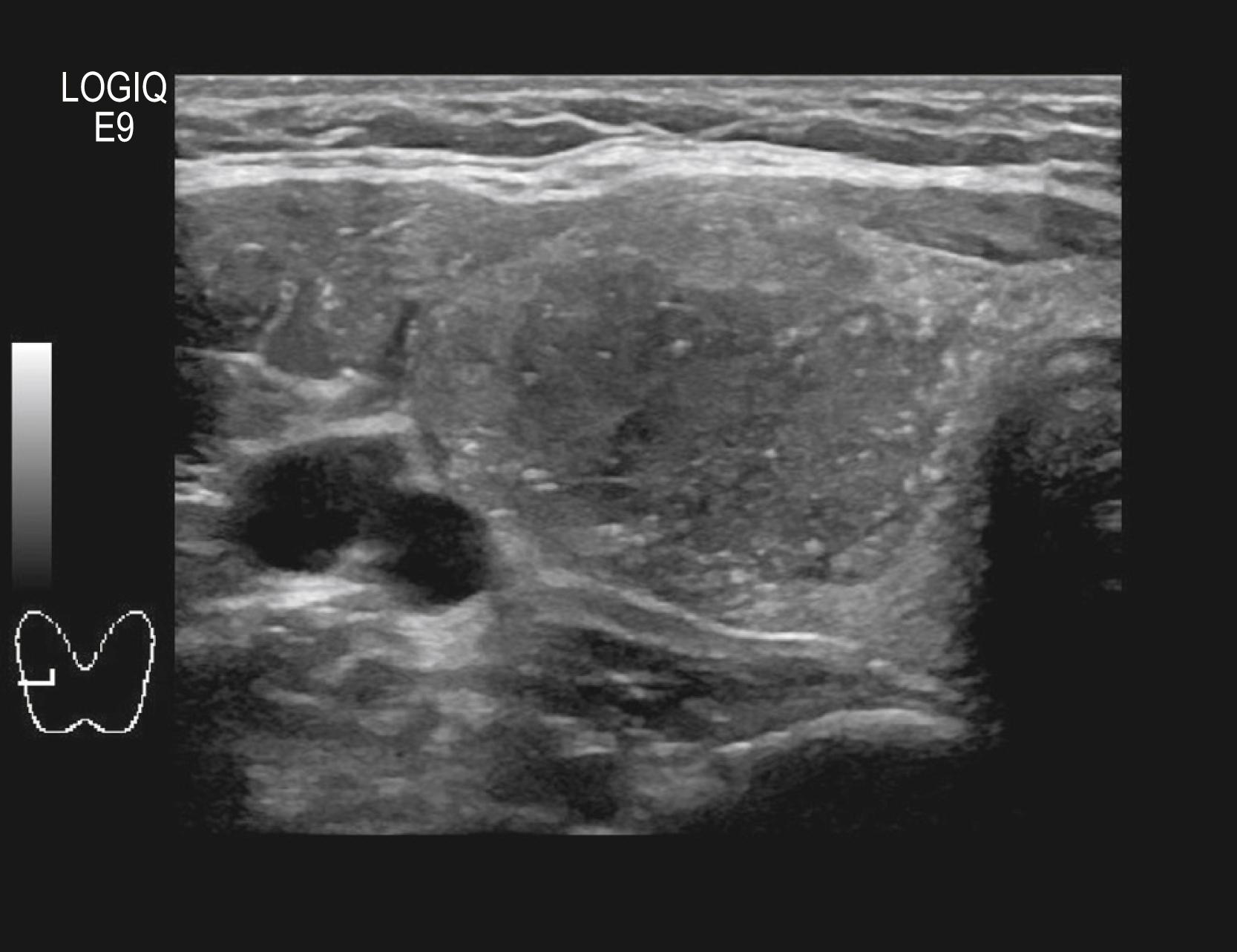
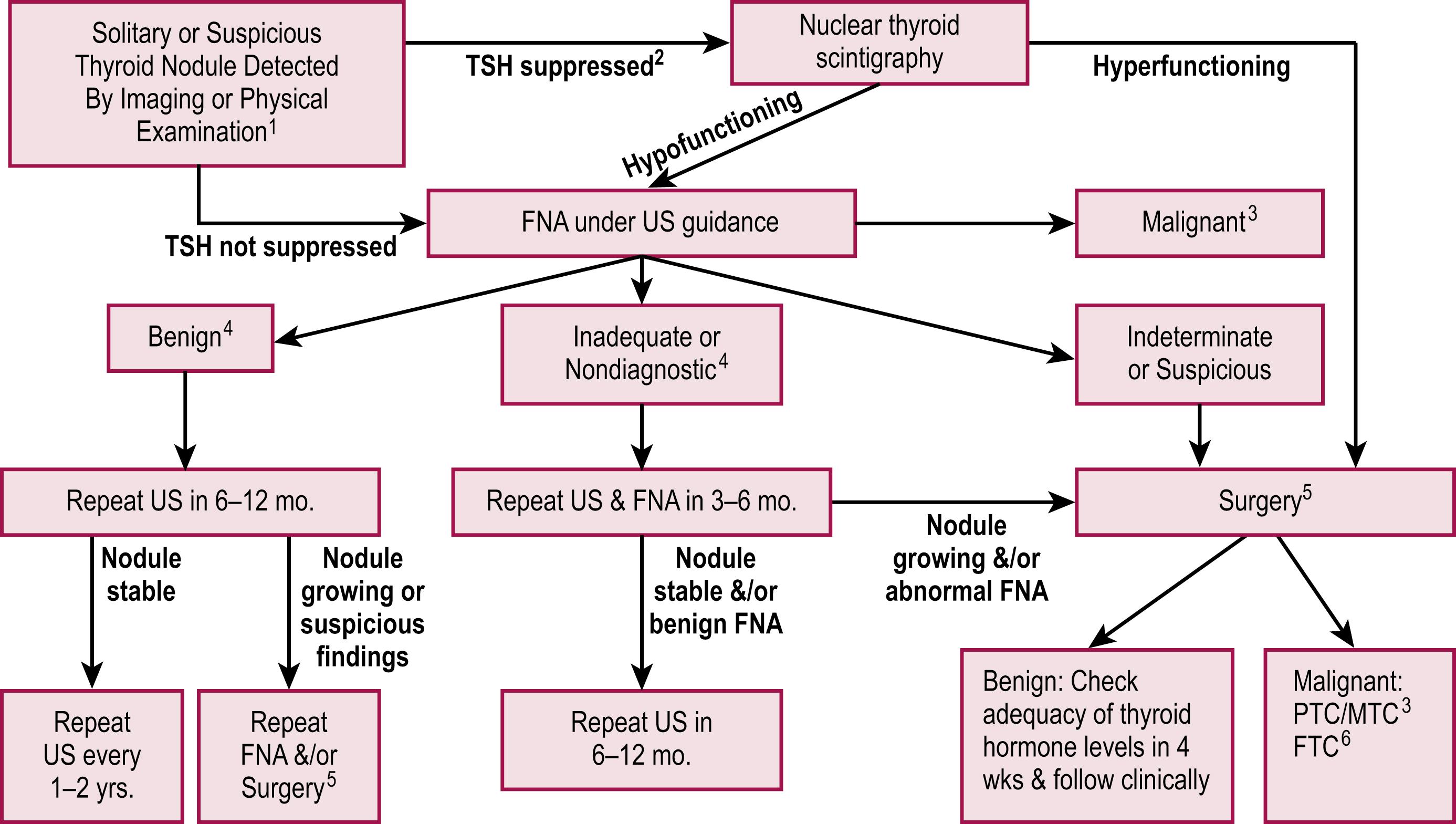
The incidence of thyroid carcinoma is increasing in both children and adults, but overall the mortality remains stable. According to one large database study of childhood thyroid cancer, the histopathology of thyroid cancer in children is similar to that in adults: 80% papillary thyroid cancer, 10% follicular thyroid cancer, 5% medullary thyroid cancer (MTC), and 2% other types of thyroid cancer. In the same study, at the time of diagnosis, thyroid cancer was found to be limited to the thyroid gland in 42% but was found in the regional lymph nodes in 46%.
Children with thyroid carcinoma present with more advanced-stage disease, a higher incidence of lymph node and pulmonary metastases, but have a lower mortality rate than adults. Prepubertal children have a greater degree of extrathyroid extension, lymph node involvement, and lung metastases at diagnosis compared with adolescents.
Exposure to radiation is a significant risk factor for developing thyroid cancer as well as nonmalignant thyroid disease. A 62-fold increase in thyroid tumors was noted in the Republics of Belarus and Ukraine after the 1986 Chernobyl nuclear power plant catastrophe. The tumors presented with increased tumor spread, local invasion, and nodal metastases. The use of radiation for diagnostic purposes has also been linked to an increase in childhood cancers. It is estimated that computed tomography (CT) scans increase the risk of malignancy as much as one fatal cancer per 1000 CT scans.
Thyroid cancers constitute about 10% of second malignancies, with treatment for previous malignancies being a risk factor for thyroid cancer. Hodgkin lymphoma is the most common malignancy associated with a subsequent thyroid cancer, followed by non-Hodgkin lymphoma, and leukemia. Female gender, younger age at exposure, and time since exposure were found to be significant modifiers of the radiation related risk of secondary thyroid cancer. This is related to both previous radiation exposure to the neck, or less commonly chemotherapeutic treatment with alkylating agents.
The disparity in behavior of the different histologic subtypes of thyroid cancer may be related to various molecular findings. RAS proto-oncogene mutations are found in about 20% of papillary tumors and 80% of follicular tumors. RAS has also been shown to be frequently activated in benign follicular adenomas, suggesting this genetic event occurs early in the transformation process. About 35% of papillary thyroid cancers have an activating mutation of the RET proto-oncogene. The RET protein is a receptor tyrosine-kinase molecule, which functions on an intracellular level to regulate proliferation or differentiation. It may be responsible for the development of MTC. Specific point mutations are associated with the multiple endocrine neoplasm (MEN) type 2 (MEN 2A, MEN 2B) syndromes and familial MTC (FMTC). In addition, as many as 40% of patients with sporadic MTCs possess RET mutations. Integrating molecular testing will likely become front-line management for pediatric thyroid nodules, both malignant and those with indeterminate cytology on FNA. However, at this time, further studies are required for it to become part of routine clinical practice.
There are several hereditary syndromes with specific known chromosomal abnormalities that increase the risk of both malignant and nonmalignant thyroid neoplasms. For example, familial adenomatous polyposis, with an abnormality of the APC gene (5q21–q22 chromosomal location), results in an increased risk of papillary thyroid cancer. Patients with familial non-MTC cancers have more aggressive tumors with increased rates of extrathyroid extension, lymph node metastases, an earlier age at disease onset, and increased severity in successive generations. The ATA recommends that patients at an increased risk of developing familial thyroid cancer should be referred to centers of excellence (COEs) to obtain appropriate evaluation, follow-up, genetic counseling, and treatment.
Thyroid carcinoma usually presents clinically as a thyroid mass, sometimes with enlarged cervical lymph nodes. Regional lymph node metastases are present in three-fourths of children at the time of diagnosis. The diagnosis of thyroid carcinoma requires appropriate imaging and histologic examination, with the workup of a suspicious thyroid nodule including US and US-guided FNA as described previously. Suspicious or intermediate results on FNA mandate operative resection, usually lobectomy and isthmusectomy, with completion thyroidectomy or observation with or without TSH suppression depending on final histopathology. The Bethesda classification for cytology, with associated categories of cancer risk, is accurate in adults. In children, it accurately identifies benign nodules (Bethesda Category II). However, other categories (Bethesda Category III–V), which have lower rates of malignancy in adults, have very high rates of malignancy in children.
The preoperative workup for a child with a newly diagnosed papillary thyroid carcinoma on FNA includes a comprehensive neck US including central and lateral neck compartments with a high-resolution probe and an experienced ultrasonographer. The goal of US assessment is to identify locoregional metastases and therefore direct FNA of suspicious lymph nodes. Additional cross-sectional imaging for operative planning should be considered in patients with bulky disease or vocal cord paralysis. These patients should ideally be referred to COEs and treated by experienced multidisciplinary teams for optimal treatment.
Children diagnosed with papillary thyroid cancer should undergo total thyroidectomy due to an increased incidence of multifocal and bilateral disease (see Fig. 75.3 ). If a total thyroidectomy is not performed, there is an increased risk of recurrence or the need for more operations. The ATA recommends performing a central lymph neck dissection (CLND) in children with clinical evidence of invasion outside the thyroid gland, and/or if locoregional metastases are found either intraoperatively or on preoperative imaging, as there is an increased disease-free survival with CLND in these children. In children without these findings, CLND should be considered based on whether the disease is focal or more diffuse, the size of the tumor, and the surgeon’s experience. In children with unifocal disease, ipsilateral CLND can be considered. The neck dissection should be complete and compartment based, not based on cherry-picking or palpation. The ATA guidelines do not recommend routine lateral neck dissections, but indicate it should be performed on patients with positive FNA of clinically or radiographically suspicious lymph nodes in the lateral neck. Postoperative staging and surveillance is dependent on the ATA Pediatric Thyroid Cancer Risk Levels, which are derived from the American Joint Commission for Cancer TNM classification system, and stratifies patients as low risk, intermediate risk, or high risk. Staging is usually performed within 12 weeks after resection and allows for stratification of patients who may benefit from further resection or 131 I therapy. It usually includes 123 I diagnostic whole body scans (except for ATA pediatric low-risk patients), TSH-stimulated thyroglobulin, and may include neck US or positron emission tomography(PET)/computed tomography (CT). 131I therapy is indicated for the treatment of nodal or other locoregional disease that cannot be resected as well as distant metastases. Neck US surveillance should be performed 6 months postoperatively, and then annually for ATA low-risk children, and on a 6- to 12-month basis for ATA intermediate and high-risk children. Surveillance should be continued for at least 5 years.
In the past, the reported incidence of recurrent laryngeal nerve injury has ranged from 0–24%, and permanent hypocalcemia has been found in 6–27% of patients undergoing total thyroidectomy. A more contemporary study reports a permanent recurrent laryngeal nerve injury rate of 1.1% and a permanent hypocalcemia rate of 1.1%. The most reliable way to preserve parathyroid gland function is to identify and preserve the glands at the time of thyroidectomy ( Fig. 75.4 ). If there is apparent devascularization at the time of thyroid resection, then one or two of the glands should be autotransplanted into the sternocleidomastoid muscle or the nondominant forearm. During dissection, the laryngeal nerve should be identified and protected (see Fig. 75.4 ). When the tumor invades the laryngeal nerve, the nerve and a rim of tumor can be safely preserved without compromising survival using adjuvant therapy with 131 I therapy to eradicate any residual tumor.
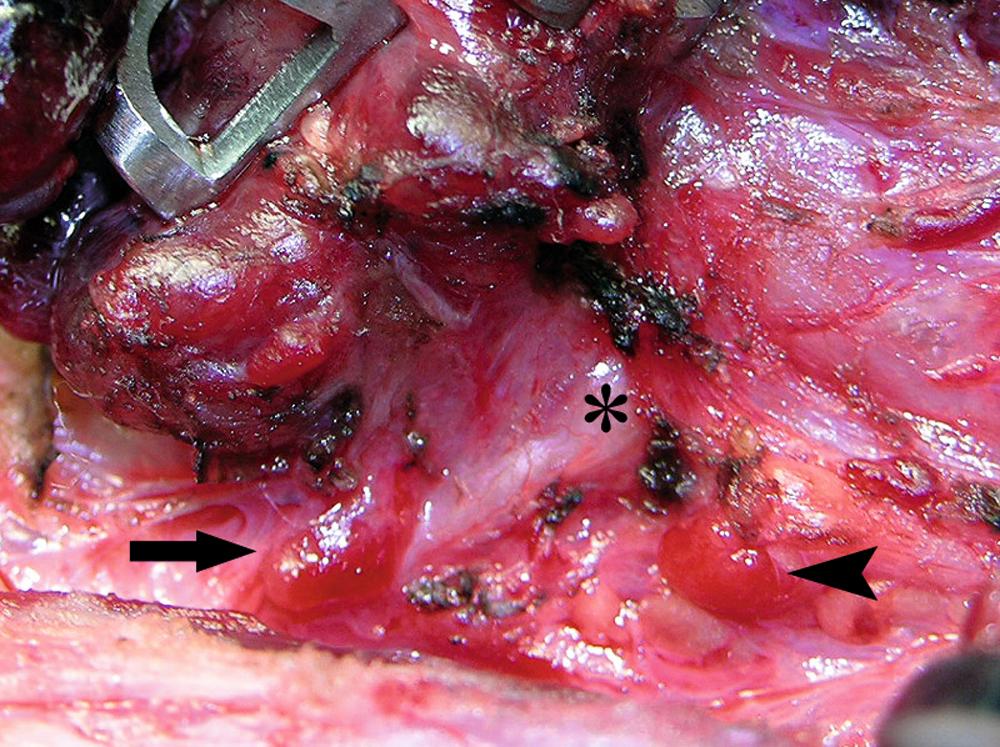
Pulmonary metastases are found in about 6% of children at the time of diagnosis, but they rarely develop in the absence of significant cervical lymph node metastases. Pulmonary metastases require treatment with radioiodine. Plain chest films demonstrate the pulmonary disease in only 60% of cases, making scanning with radioiodine necessary. The pulmonary scintiscan can be falsely negative if there is significant residual thyroid tissue in the neck.
Follicular thyroid cancer in children is rare. Less than 10% of thyroid cancer in children is follicular, and the prevalence seems to be decreasing. Due to its rarity, it is poorly studied, and therefore, management is more debatable. The ATA recommends total thyroidectomy for patients with clear vascular invasion, known distant metastases, or tumor size >4 cm. Minimally invasive follicular thyroid cancer with minimal or no vascular invasion (three or fewer vessels involved) can be treated with lobectomy and 131 I therapy, but treatment should be decided on a case-by-case basis. Children with follicular thyroid cancer should be considered for genetic counseling and genetic testing for germline PTEN mutations. The PTEN gene encodes for the Phosphatase and Tensin homologue protein, and is a tumor suppressor gene.
MTC accounts for approximately 1–2% of thyroid cancers in the United States, and 5% of pediatric thyroid neoplasms. Arising from the parafollicular C cells, MTC occurs either sporadically or in association with MEN 2A, or 2B, or the FMTC syndrome. MTC is usually the first tumor to develop in patients with the MEN syndrome, and is the most common cause of death in this group. The neoplasm is particularly virulent in patients with MEN 2B and can be found in infancy.
In the setting of nonfamilial MTC, the diagnosis is usually made only after metastatic spread of the tumor has occurred to the adjacent cervical lymph nodes or to distant sites. Resection is the only effective treatment for MTC, underscoring the importance of early diagnosis and therapy before metastases occur. Recently revised ATA management guidelines for MTC do not differentiate between adults and children except for the role of prophylactic thyroidectomy. Therefore, a child with an FNA diagnosis of MTC should undergo a complete US of the neck with a high-resolution probe and Doppler evaluation, similar to papillary thyroid carcinoma. Serum levels of calcitonin and carcinoembryonic antigen (CEA) should be checked, as well as DNA analysis for RET germline mutation ( Fig. 75.5 ). If the child is RET positive, they should be evaluated for a pheochromocytoma and hyperparathyroidism ( Fig. 75.6 ). If a pheochromocytoma is present, an adrenalectomy should be performed prior to thyroidectomy. If hyperparathyroidism is present, it can be treated at the time of the thyroidectomy.
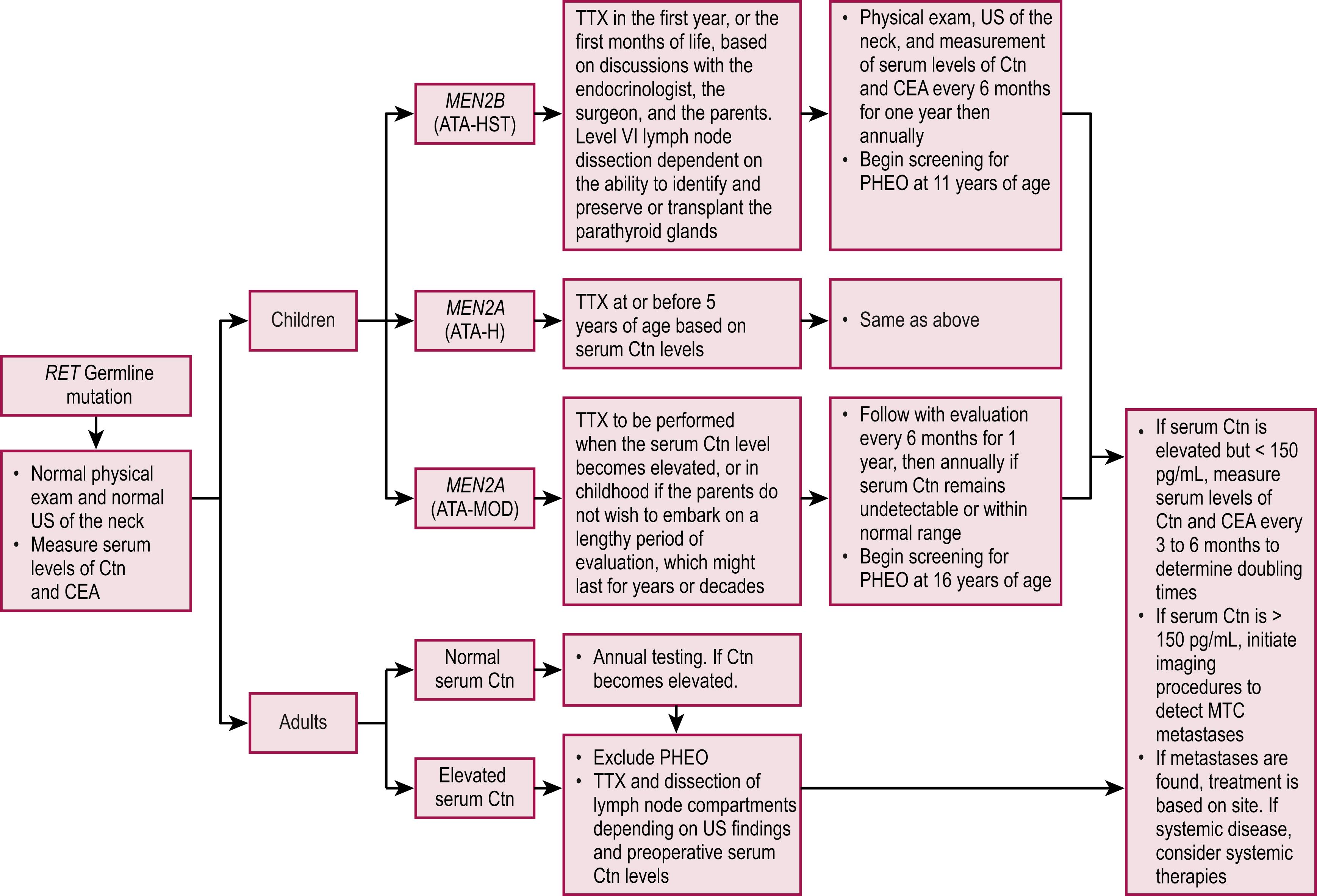
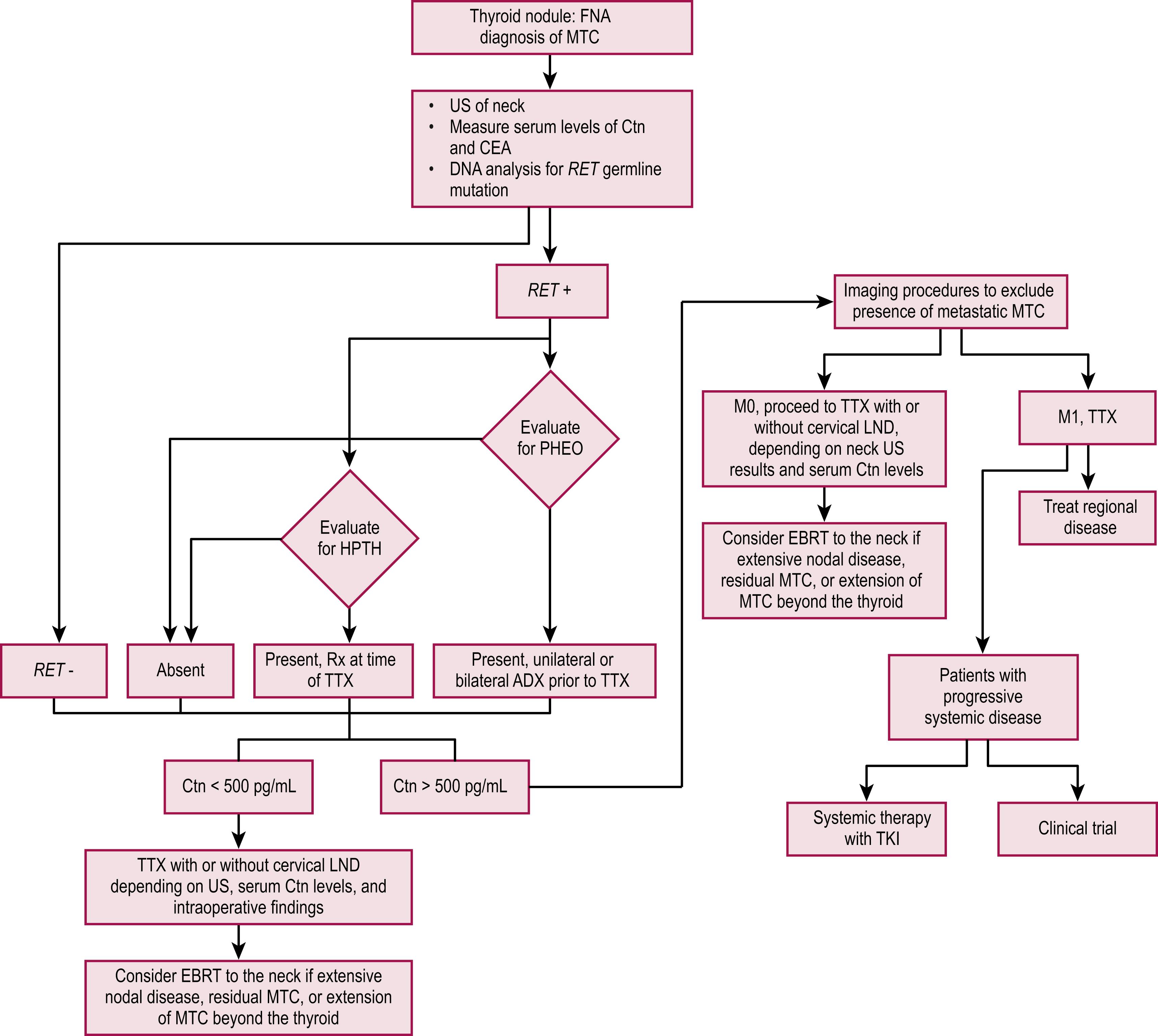
The calcitonin levels and the US findings help determine the need for a lateral neck dissection at the time of thyroidectomy. For patients with a calcitonin <500 pg/mL and no suspicious US findings in the lateral neck, total thyroidectomy and central neck dissection are performed. However, if there are US findings of suspicious nodes in the lateral neck, then a lateral lymph node dissection should also be performed. For patients with calcitonin >500 pg/mL and/or those with extensive neck disease, metastatic workup should ensue (including CT neck, chest, and abdomen) with total thyroidectomy reserved for patients without metastatic disease. External beam radiotherapy is a consideration for patients with extensive disease, residual disease, or extrathyroidal extension.
Since MTC in children often presents after metastatic spread has occurred, optimal management of MTC from MEN 2 and FMTC kindreds relies on the presymptomatic detection of the RET proto-oncogene mutation responsible for the disease using screening tests. In young and asymptomatic MEN 2A kindred patients found to have the RET proto-oncogene mutation during screening, prophylactic thyroidectomy has been shown to prevent or cure MTC. In one study, 66% of children and teenagers with the RET proto-oncogene mutation already had foci of MCT within the thyroid gland at the time of their prophylactic thyroidectomy. However, no child younger than 8 years of age was found to have metastatic disease at the time of operation. Moreover, when followed for 5–8 years, none of these patients had evidence of persistent or recurrent disease. It is therefore recommended that affected children with MEN 2A who are ATA high risk undergo total thyroidectomy prior to age 5 years, and those that are ATA moderate risk undergo total thyroidectomy when the serum calcitonin level becomes elevated (see Fig. 75.6 ). ATA risk stratification is based on particular RET mutations.
Prophylactic thyroidectomy should be performed at approximately age 1 year in children with MEN 2B because of the increased virulence of MTC in this population. CLND, with removal of lymph nodes medial to the carotid sheaths and between the hyoid bone and the sternum, is performed only if the parathyroid glands can be identified and preserved or transplanted. Early detection of the MTC by DNA mutation analysis and early operative intervention result in a normal life expectancy.
Parathyroid gland development commences at 5 weeks of gestation when the epithelium in the dorsal portions of the third and fourth pharyngeal pouches begins to proliferate. Usually two glands develop on each side, but this is variable, ranging from two to six glands. The inferior parathyroid glands originate from the third pharyngeal pouch, as does the thymus. The long course of descent of the thymus into the mediastinum during the sixth week of gestation explains the variable location of the inferior glands, which can even be intrathymic in position. The superior parathyroid glands originate from the fourth pharyngeal pouch with part of the thyroid, and they migrate a shorter distance to their final position on the posterior aspect of the thyroid gland.
Calcium regulation is carried out by the parathyroid gland and parathormone (PTH) in conjunction with the bones, renal system, and vitamin D. Chief cells in the parathyroid gland have a plasma membrane calcium-sensing receptor that detects serum calcium levels and activates a negative feedback system to decrease PTH production when serum calcium is high. PTH is secreted as an 84-amino-acid peptide, which is rapidly cleaved in the liver and kidney into carboxyl-terminal, amino-terminal, and mid-region fragments. Its activity resides in the amino-terminal fragment, but the half-life is only 2–3 minutes. PTH activates osteoclasts that break down bone and release calcium stores, increases renal tubular absorption of calcium, and increases gastrointestinal (GI) absorption of calcium via activation of vitamin D.
Become a Clinical Tree membership for Full access and enjoy Unlimited articles
If you are a member. Log in here